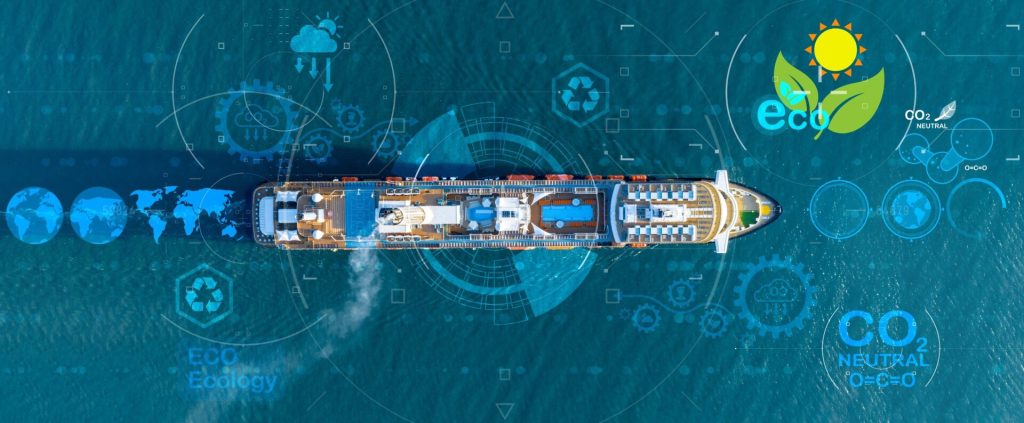A new era for ‘green’ shipping

Onboard Carbon Capture and Storage (OCCS) technology can reduce emissions by more than 100% and up to 121% when combined with biofuels.
However, the question is how this can be achieved when the ship already has a 100% reduction in emissions. Ships use biofuels made from plant or animal materials, not oil or natural gas.
As they grow, plants absorb carbon dioxide (CO2) from the atmosphere. When biofuels are burned in the ship’s engine, they release CO2 again.
However, with the new OCCS technology, the ship captures and stores the CO2 before it reaches the air, removing more carbon dioxide than it produces, thus helping to reduce pollution and protect the climate.
OCCS is a system installed inside ships that captures the CO2 produced by engines during fuel combustion, temporarily storing it for safe transport and eventual storage or recovery.
The technology is mainly based on the use of monoethanolamine (MEA), which “traps” CO2 in exhaust gases before they are released into the atmosphere.
According to a new study by the Global Centre for Maritime Decarbonisation (GCMD), carbon capture on board ships can reduce greenhouse gas emissions by up to 29%, while in combination with biofuels the reduction can reach impressive levels of up to 121%.
The COLOSSUS study, which examines the use of OCCS in medium-sized tankers, shows that the technology, especially when based on monoethanolamine (MEA), can make a significant contribution to meeting the International Maritime Organization’s (IMO) GHG Fuel Intensity (GFI) limits up to 2040.
The study’s analysis covers the entire carbon value chain, from fuel production and transportation, to ship combustion and operation, and the final storage or utilization of the captured CO2.
Remarkably, the transport and storage of CO2 adds less than 1% to total emissions.
The combination
Ships using Heavy Fuel Oil – HFO heavy fuel oil and OCCS system can remain within GFI fuel intensity limits until 2032, without the need to change fuel.
Ships using LNG fuel and the same technology extend compliance until 2035.
Combining OCCS with bio-LNG or biodiesel from used cooking oils (UCO) reaches the 2040 targets with excellent savings results.
The use of captured CO2 to produce electronic methanol with renewable electricity allows ships using this fuel to claim an additional 17% greenhouse gas emission savings.
Despite the impressive environmental benefits, OCCS also has challenges.
The cost per tonne of CO2 captured ranges between 269-405 US dollars, according to the study, based on a 40% capture rate and full recovery of waste heat.
Lynn Loo, CEO of the Global Centre for Maritime Decarbonisation (GCMD), said:
“We hope this study lays the foundation for a realistic regulatory framework around OCCS, which will allow policymakers to make informed decisions about the future of shipping.”
The IMO has already begun work on defining the regulatory framework for OCCS, with a target of completion by 2028, including specifications for the safe capture, transport and storage of CO2 from ships in dedicated onshore facilities.
The study shows that the technology can help ships comply with the targets for 2032, 2035 and 2040, depending on the fuel and the rate of CO2 capture.
It describes how CO2 can be captured from ships’ exhaust gases, stored safely on board and transported to certified reception or storage facilities.
COLOSSUS (Carbon capture, offloading, onshore storage, utilisation and permanent storage), with a life cycle assessment, provides the shipping industry with a detailed analysis of the emission reduction potential of OCCS across the entire carbon value chain.
However, despite the shipping industry’s ability to help the shipping industry decarbonize, a number of challenges need to be addressed in the OCCS sector.
Specifically, according to an industry analysis conducted by GCMD and its partners in October last year, the main barriers to this technology include recurring additional costs due to fuel penalties, solvent amine replenishment, manpower, maintenance and offloading services.
Furthermore, the project partners argued that, as the offloading of captured carbon dioxide is still in its infancy, it is hampered by the lack of clear national and port regulations to monitor and handle its final disposal.
It is noted that global shipping is called upon to achieve zero carbon emissions by 2050 and OCCS technology is becoming a key ally in this transition, offering a realistic, technically mature and environmentally effective solution.
Οι απόψεις που εκφράζονται στα σχόλια των άρθρων δεν απηχούν κατ’ ανάγκη τις απόψεις της ιστοσελίδας μας, το οποίο ως εκ τούτου δεν φέρει καμία ευθύνη. Για τα άρθρα που αναδημοσιεύονται εδώ με πηγή, ουδεμία ευθύνη εκ του νόμου φέρουμε καθώς απηχούν αποκλειστικά τις απόψεις των συντακτών τους και δεν δεσμεύουν καθ’ οιονδήποτε τρόπο την ιστοσελίδα.


